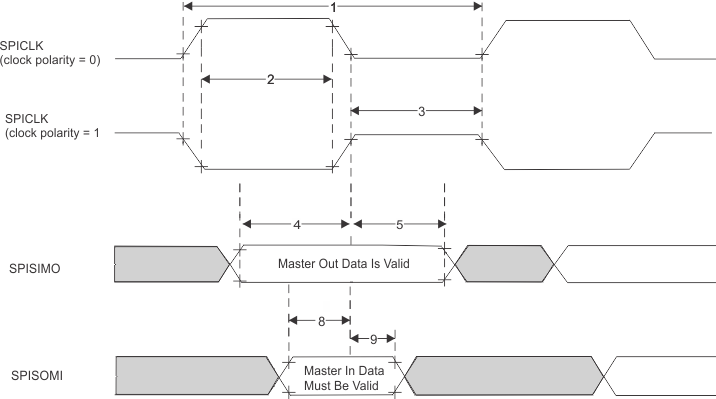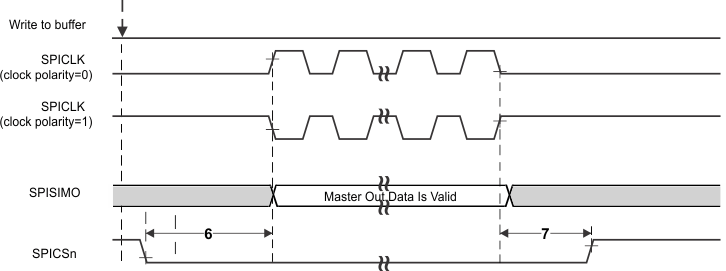ZHCSH27B May 2017 – April 2018 IWR1642
PRODUCTION DATA.
- 1 器件概述
- 2 修订历史记录
- 3 Device Comparison
- 4 Terminal Configuration and Functions
-
5 Specifications
- 5.1 Absolute Maximum Ratings
- 5.2 ESD Ratings
- 5.3 Power-On Hours (POH)
- 5.4 Recommended Operating Conditions
- 5.5 Power Supply Specifications
- 5.6 Power Consumption Summary
- 5.7 RF Specification
- 5.8 CPU Specifications
- 5.9 Thermal Resistance Characteristics for FCBGA Package [ABL0161]
- 5.10
Timing and Switching Characteristics
- 5.10.1 Power Supply Sequencing and Reset Timing
- 5.10.2 Input Clocks and Oscillators
- 5.10.3
Multibuffered / Standard Serial Peripheral Interface (MibSPI)
- 5.10.3.1 Peripheral Description
- 5.10.3.2
MibSPI Transmit and Receive RAM Organization
- Table 5-7 SPI Timing Conditions
- Table 5-8 SPI Master Mode Switching Parameters (CLOCK PHASE = 0, SPICLK = output, SPISIMO = output, and SPISOMI = input)
- Table 5-9 SPI Master Mode Input Timing Requirements (CLOCK PHASE = 0, SPICLK = output, SPISIMO = output, and SPISOMI = input)
- Table 5-10 SPI Master Mode Switching Parameters (CLOCK PHASE = 1, SPICLK = output, SPISIMO = output, and SPISOMI = input)
- Table 5-11 SPI Master Mode Input Requirements (CLOCK PHASE = 1, SPICLK = output, SPISIMO = output, and SPISOMI = input)
- 5.10.3.3 SPI Slave Mode I/O Timings
- 5.10.3.4 Typical Interface Protocol Diagram (Slave Mode)
- 5.10.4 LVDS Interface Configuration
- 5.10.5 General-Purpose Input/Output
- 5.10.6 Controller Area Network Interface (DCAN)
- 5.10.7 Serial Communication Interface (SCI)
- 5.10.8 Inter-Integrated Circuit Interface (I2C)
- 5.10.9 Quad Serial Peripheral Interface (QSPI)
- 5.10.10 ETM Trace Interface
- 5.10.11 Data Modification Module (DMM)
- 5.10.12 JTAG Interface
- 6 Detailed Description
- 7 Monitoring and Diagnostics
- 8 Applications, Implementation, and Layout
- 9 Device and Documentation Support
- 10Mechanical, Packaging, and Orderable Information
Table 5-9 SPI Master Mode Input Timing Requirements (CLOCK PHASE = 0, SPICLK = output,
SPISIMO = output, and SPISOMI = input)(1)
| NO. | MIN | TYP | MAX | UNIT | ||
|---|---|---|---|---|---|---|
| 8(2) | tsu(SOMI-SPCL)M | Setup time, SPISOMI before SPICLK low
(clock polarity = 0) |
5 | ns | ||
| tsu(SOMI-SPCH)M | Setup time, SPISOMI before SPICLK high
(clock polarity = 1) |
5 | ||||
| 9(2) | th(SPCL-SOMI)M | Hold time, SPISOMI data valid after SPICLK low
(clock polarity = 0) |
3 | ns | ||
| th(SPCH-SOMI)M | Hold time, SPISOMI data valid after SPICLK high
(clock polarity = 1) |
3 | ||||
(1) The MASTER bit (SPIGCR1.0) is set and the CLOCK PHASE bit (SPIFMTx.16) is cleared.
(2) The active edge of the SPICLK signal referenced is controlled by the CLOCK POLARITY bit (SPIFMTx.17).
 Figure 5-4 SPI Master Mode External Timing (CLOCK PHASE = 0)
Figure 5-4 SPI Master Mode External Timing (CLOCK PHASE = 0)  Figure 5-5 SPI Master Mode Chip Select Timing (CLOCK PHASE = 0)
Figure 5-5 SPI Master Mode Chip Select Timing (CLOCK PHASE = 0)